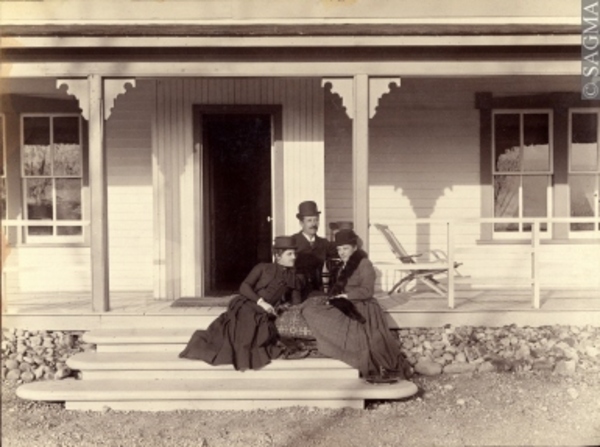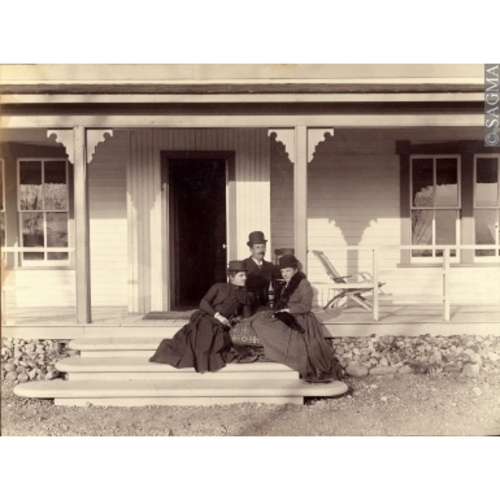
Source: Link
GALT, ELLIOTT TORRANCE, office holder, businessman, and developer; b. 24 May 1850 in Sherbrooke, Lower Canada, son of Alexander Tilloch Galt* and Elliott Torrance; d. unmarried 15 May 1928 in New York City.
The son of a prominent businessman and politician, Elliott Galt was educated at Bishop’s College in Lennoxville, Lower Canada, and then at Harrow, England, and Tours, France. In the late 1860s he visited several European capitals, meeting many of his father’s business associates. From 1869 he clerked in the offices of Montreal businessmen, including that of John Rose*. Apparently, Galt did not take life seriously and in 1879 his father asked Prime Minister Sir John A. Macdonald* to post him somewhere away from his friends and “life of self indulgence.” Macdonald obliged and made Elliott secretary and clerk to Edgar Dewdney*, newly appointed Indian commissioner in the North-West Territories. Without giving up these positions, Galt became assistant Indian commissioner at Regina in 1881.
Galt adapted well to the northwest. Tall and lean, soft-spoken and scholarly, he loved outdoor sports, and his legendary billiard skills stood him in good stead in western bars and hotels. In his short career with Dewdney, whose main task was to pacify the aboriginal people and settle them on reserves, Galt visited most of the southern territories and experienced, with patience and good humour, all the hardships of sleeping for weeks on end in a tent on the open prairies. He recognized the enormous investment potential of the region and speculated heavily in real estate. He also sent his father coal samples from the southwestern corner of the plains.
In 1883 Galt resigned his posting and became the general manager of the North-Western Coal and Navigation Company Limited, which was intending to open a coalmine on the Belly (Oldman) River at present-day Lethbridge, Alta. Although Alexander Galt had secured the necessary capital in London, it was Elliott who supervised the operation, including the construction of a steamboat, the Baroness, designed to haul coal to the main line of the Canadian Pacific Railway at Medicine Hat. The following year he built two more steamers, the Alberta and the Minnow, but low water levels thwarted the enterprise. In fact, the vessels served their most useful and lucrative role as troop carriers after the defeat in 1885 of Louis Riel* and his followers.
Meanwhile, Alexander Galt persuaded his British associates, principally William Henry Smith and his partner William Lethbridge of bookstall fame, to underwrite the Alberta Railway and Coal Company, which would eventually absorb all the assets of North-Western Coal and Navigation. Under Elliott’s supervision, AR&C built a narrow-gauge railway from Lethbridge to the CPR at Dunmore, near Medicine Hat. Galt completed the project in August 1885 and began shipping coal. Since the CPR was the colliery’s principal customer, the Galt mines endured a feast-or-famine existence, dependent entirely upon the needs and whims of the railway company. To remain profitable, Elliott Galt expanded the mines and installed the most modern machinery available. On several occasions he defeated striking miners and lowered wages. To break out of the CPR stranglehold, he and some American associates built a railway in 1890 from Lethbridge to the ore-reduction plant of the Anaconda Copper Mining Company at Great Falls, Mont. In 1893, the year his father died, Galt negotiated with Thomas George Shaughnessy the lease to the CPR of both the AR&C’s Dunmore-Lethbridge line and the Crowsnest Pass charter it had acquired in 1890; he converted this deal into an outright sale four years later.
The company’s collieries continued to expand, becoming one of the largest operations in western Canada, but they remained subject to the vagaries of a peripheral economy. What made the Galt enterprise a success was the relatively large land grants earned for constructing the railways. Totalling over one million acres, these holdings were most suitable for grazing purposes. Since ranch lands were comparatively low in value, in 1893 Galt formed the Alberta Irrigation Company, which proposed to purchase the lands from AR&C, build irrigation canals, and offer the holdings for sale as more profitable agricultural lands. “In our case,” Galt later explained, “we had to spend large sums of money to give our land value.” In 1896, after years of intense lobbying by Galt and his assistant (and future brother-in-law) Charles Alexander Magrath*, as well as by William Pearce, the northwest’s senior federal civil servant, the government permitted the company to receive its land in a solid block. With Clifford Sifton, the minister of the interior, signalling government support for the scheme, Galt in 1898 concluded a deal with the Church of Jesus Christ of Latter-day Saints in Utah, by which the Mormons would provide canal-construction crews for a payment to be made half in land and half in cash [see Charles Ora Card*]. Begun that year, the 115-mile canal system was completed in 1900.
Although Galt had no problem disposing of the irrigated lands, he continued to support projects in the region. In 1901 he helped Jesse W. Knight, one of the Mormon settlers, establish a large sugar-beet farm and refinery. The following year he extended the irrigation canal, earning a further 500,000 acres, and in 1903 he completed a branch line, the St Mary’s River Railway, from the AR&C line at Stirling to Cardston. Meanwhile, he donated lands near Lethbridge for a model farm; transformed into a dominion experimental farm in 1906 [see Sydney Arthur Fisher], it would become renowned as a research station. He also enlarged the local hospital and gave generously to congregations building their first churches. Although he kept a low profile in Lethbridge, he was influential in local politics. In 1890 he had successfully refused to endorse the town’s incorporation unless his companies were exempt from local taxes, except the school levy.
With the completion of the irrigation works, Galt began preparations for his retirement. In 1901 he widened the Canadian section of the Great Falls railway to standard gauge and sold the American portion to James Jerome Hill*’s Great Northern Railroad. Three years later he organized the Alberta Railway and Irrigation Company, which absorbed all the Galt companies. Although named its president, Galt effectively withdrew from the operation because of ill health; in 1905 Augustus Meredith Nanton became managing director, and it was he who spoke for the company during the bitter mineworkers’ strike the following year [see Frank Henry Sherman*]. In 1907 Galt tightened the already close relationship between AR&I and the CPR. He negotiated a deal whereby the CPR, already the owner of AR&C’s Dunmore-to-Lethbridge line, purchased a controlling interest in the new company. Formalized in 1908, the arrangement was extended in 1912 when the CPR acquired all the assets of AR I. As for Galt, he had left Lethbridge in 1908 to spend his retirement years in Montreal and Victoria. He died in New York, where he had gone for medical treatment, of complications arising from a heart attack; he was buried in Mount Royal Cemetery in Outremont (Montreal).
[Elliott Torrance Galt did not leave any personal papers; documentary evidence for his career can be found only in ancillary records. Useful material for tracing the history of the mining and railway companies is contained in the following collections at the NA: the A. T. Galt papers (MG 27, I, D8); Sir John A. Macdonald papers (MG 26, A); the Van Horne and Shaughnessy letter-books in the Canadian Pacific Railway papers (MG 28, III 20); the C. A. Magrath papers (MG 30, E82); the records of the Department of the Interior (RG 15); and the Sir Clifford Sifton papers (MG 27, II, D15). The GA holds a number of invaluable records in its Alberta Railway and Irrigation Company fonds (M 2431, M 2533, M3748–50, M 7899, M 8532) as well as a microfilmed copy of a company scrapbook (BR, Alberta Railway). The PRO holds the incorporation documents and two lists of shareholders for the Northwestern Coal and Navigation Company. The invaluable William Pearce fonds in the Univ. of Alta. Arch. (Edmonton) is essential for the study of irrigation in Alberta. A complete record of the legislative history of the Galt companies is contained in Can., Statutes.
Five letters written by Galt to his mother while he was Dewdney’s assistant have been published as “Letters from Elliott Galt: travelling the prairies, 1879–80,” ed. A. A. den Otter, Alberta Hist. (Calgary), 26 (1978), no.3: 21–33. The Manitoba Free Press for 9 Sept. 1904 has a comprehensive story on the Galt enterprises as well as an extensive interview with Elliott Galt, including the quotation cited in the text. The two most recent works which discuss his career are A. A. den Otter, Civilizing the west: the Galts and the development of western Canada (Edmonton, 1982) and H. B. Timothy, The Galts: a Canadian odyssey (2v., Toronto, 1984–87), 2. Marginally useful are C. A. Magrath, The Galts, father and son, pioneers in the development of southern Alberta . . . ([Lethbridge, Alta, 1935]); O. D. Skelton, The life and times of Sir Alexander Tilloch Galt, ed. Guy MacLean (new ed., Toronto, 1966); and E. C. Springett, For my children’s children (Montreal, 1937). a.a.den o.]§
Cite This Article
A. A. den Otter, “GALT, ELLIOTT TORRANCE,” in Dictionary of Canadian Biography, vol. 15, University of Toronto/Université Laval, 2003–, accessed December 31, 2025, https://www.biographi.ca/en/bio/galt_elliott_torrance_15E.html.
The citation above shows the format for footnotes and endnotes according to the Chicago manual of style (16th edition). Information to be used in other citation formats:
| Permalink: | https://www.biographi.ca/en/bio/galt_elliott_torrance_15E.html |
| Author of Article: | A. A. den Otter |
| Title of Article: | GALT, ELLIOTT TORRANCE |
| Publication Name: | Dictionary of Canadian Biography, vol. 15 |
| Publisher: | University of Toronto/Université Laval |
| Year of publication: | 2005 |
| Year of revision: | 2005 |
| Access Date: | December 31, 2025 |



